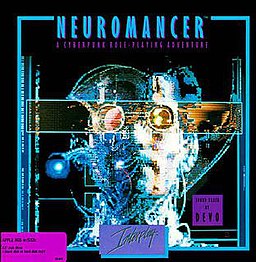Neuromancer (video game)
| Neuromancer | |
|---|---|
 Cover art | |
| Developer(s) | Interplay Productions |
| Publisher(s) | Mediagenic |
| Producer(s) | Brian Fargo, Troy P. Worrell |
| Designer(s) | Bruce Balfour, Brian Fargo, Troy A. Miles, Michael Stackpole |
| Programmer(s) | Troy A. Miles |
| Artist(s) | Charles H. H. Weidman III |
| Composer(s) | Kurt Heiden, David Warhol |
| Platform(s) | Amiga, Apple II, Apple IIgs, Commodore 64, DOS |
| Release | 1988 |
| Genre(s) | Adventure |
| Mode(s) | Single player |
Neuromancer is a computer adventure game created by Interplay Productions in 1988 and distributed by Mediagenic (a brand name that Activision was also known by). It is based loosely on William Gibson's 1984 novel of the same name and takes place in both the "real world" and the extensively realized and detailed world of cyberspace. It is also noted for having a soundtrack based on the Devo song "Some Things Never Change". The gaming rights at the time were owned by Timothy Leary, who brought the project to Interplay to develop.
Plot
The game is loosely based on the events of the novel Neuromancer by William Gibson. Locations, characters, items and nuances of cyberspace from the novel appear.
Taking place in the year 2058 in Chiba City, Japan, the plot centered around the protagonist attempting to discover the truth behind the mysterious disappearances of his friends as well as other, less friendly cyberspace cowboys. Unfortunately, the player's character has fallen on hard times and has had to pawn his cyberspace deck. He awakes in a plate of Ratz' famous spaghetti, and the first order of business is to find some way to retrieve his old deck from the nearby pawnshop.
Gameplay
The gameplay was split between a traditional adventure setting, where a player could interact with 'real world' inhabitants within Chiba City, and a 3D grid representation of cyberspace once he'd managed to regain access. Different 'real world' locations led to different grid sectors, thus developing the plot and enriching the immersion.
Cyberspace combat was also simulated in the game as the player attempted to breach ICE (Intrusion Countermeasure Electronics) to gain entry to database nodes and potentially face the formidable AIs (Artificial Intelligences) that hide behind them. 'Combat' with ICE consisted of the ICE and the player doing damage to each other (the former through a built-in attack form, the latter based on what programs the player ran; some programs did one-time damage, some did damage over time for a while, and some had other effects such as slowing down the ICE) until either the ICE 'cracked' or the player was kicked out of cyberspace. Combat with AIs was similar, except that AIs were damaged primarily with skills rather than programs; were invulnerable until hit at least once with a specific skill or program; and the result of 'losing' was character death. Neuromancer was somewhat forgiving of even 'death', as a deceased character would be reanimated for the price of whatever money was in his credit chip at the time of death.
Skills and abilities can be purchased as "skill chips" that can be used in a brain jack implanted in the protagonist's head, giving him an edge in a variety of situations. Skills could also increase with successful completion of a difficult task.
The game also used a code wheel as a form of copy protection. The code wheel was necessary to access the PAX terminals in the game at certain points and without it, the player hits a dead-end in the plot.
Reception
Computer Gaming World gave Neuromancer a very favorable review, citing the game's pacing and wit, as well as the use of Gibson's setting. Combat was also praised, as was the reward of information for winning combat. The only complaints it had about the game were the predetermined responses in conversation, and the excessive use of disk swapping.[1] The magazine awarded it a title of "Adventure Game of the Year"[2] and in 1996 included it on a list of the "150 Best Games of All Time".[3] Compute! also favorably reviewed the game, citing the graphics, user interface, and the Devo soundtrack, and only criticizing the "adolescent jokes".[4] The magazine named the game to its list of "nine great games for 1989".[5]
References
- ^ Seacat, Douglas (March 1989), "Cyberspace Rider", Computer Gaming World, pp. 40, 51
{{citation}}: CS1 maint: date and year (link) - ^ "Game of the Year Awards", Computer Gaming World, p. 8, October 1989
{{citation}}: CS1 maint: date and year (link) - ^ Computer Gaming World, November 1996
- ^ Farrell, Keith (April 1989). "Neuromancer". Compute!. p. 62. Retrieved 11 November 2013.
- ^ Gutman, Dan (July 1989). "Nine for '89". Compute!. p. 19. Retrieved 11 November 2013.
